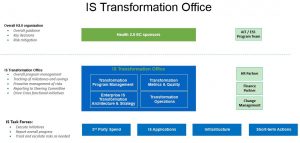 As we shared in our early-December IS town hall, and in the IS vision/strategy throughout the last quarter of 2018, the year ahead is going to be highly tranformational for IS, as we align to the Health 2.0 priorities, support our vision of “Health for a better world,” and help our organization transform to meet the changing healthcare landscape and needs of the PSJH business.
As we shared in our early-December IS town hall, and in the IS vision/strategy throughout the last quarter of 2018, the year ahead is going to be highly tranformational for IS, as we align to the Health 2.0 priorities, support our vision of “Health for a better world,” and help our organization transform to meet the changing healthcare landscape and needs of the PSJH business.
One way to demonstrate just how transformational the year ahead will be for IS is to look at the growth in the IS capital budget. Capital investment reflects the commitment an organization makes to a core strategy. In this case, the investment reflects our focused commitment to drive the PSJH Health 2.0 vision forward, with 60 percent capital budget growth over 2018. (2018 reflected a 42% growth over 2017.)

To ensure IS is able to support this broad body of work, PSJH leadership is leveraging best practices from other industries and realigning existing project leadership roles into a dedicated “office.” Called the IS Transformation Office, this function will be accountable to look across our portfolio of projects and programs, then to plan for interconnections, dependencies, and impacts, in order to ensure that all of our efforts produce the expected output.
Establishing this group to ensures we are delivering the ongoing service our partners expect, while also working to redefine the portfolio of technologies the organization operates on. Given this vast amount of project work, it’s also critical we ensure the capacity needed to successfully meet all of our commitments.
“It’s more than just having an IS Gantt chart, but means providing a comprehensive, multi-dimensional view of the work IS does, how it’s interconnected, and how it impacts the entire PSJH org, down to the caregivers working through the changes we are implementing on them,” says Chris.
In support of all of these efforts, IS is adopting industry best practice by setting up a dedicated “transformation office” (ISTO) to help ensure we plan this broad body of work appropriately. The structure of ISTO has been used by other large organizations to successfully navigate through large-scale transformation.
Outline of ISTO functions and owners
- Overall IS transformation portfolio management (Kim Dawson)
Provide program leadership and oversight for the successful planning and execution of the projects and initiatives to support the Health 2.0 vision. Execute the ISTO program management governance model.
- Financial transparency and planning (Jelena Ramsey)
Provide financial and operational metric oversight for individual and portfolio initiatives in support of the Health 2.0 vision. Ensures all projects have financial plans and track to these plans through project lifecycles.
- IS operating model (Karen McLaughlin)
Provide leadership and support for the creation and/or modification of processes, tools, and caregiver governance in support of the Health 2.0 vision. Establishes and supports processes to address “shadow IS,” IT-focused roles and spend that live outside of IS.
- IS strategy and architecture (cross-functional work group)
This function is in development and will likely be a cross-functional work group focused on developing a single, integrated, forward-facing roadmap for all of our IS technologies.
The ISTO model has been reviewed and approved by the IS exec team, the IS Joint Operations body, and our CFO, Venkat Bhamidipati, to whom our new CIO BJ Moore will report directly.
In the coming weeks and months, we look forward to sharing additional details on this work.
Contact
For more information, please reach out to Chris Briggs, VP, IS Administrative, Management & Consulting Services.
